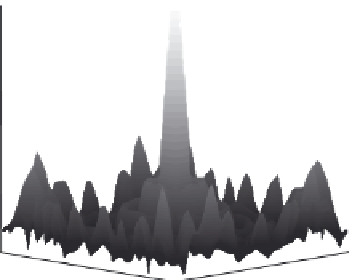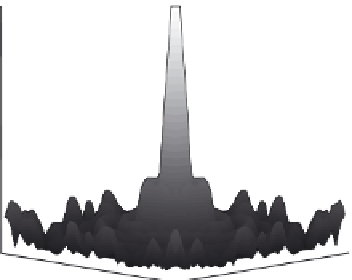Biomedical Engineering Reference
In-Depth Information
1
1
n = 32
n = 64
0.5
0.5
0
5
0
5
5
5
0
0
0
0
-5 -5
-5 -5
y (mm)
x (mm)
y (mm)
x (mm)
1
1
n = 128
n = 256
0.5
0.5
0
5
0
5
5
5
0
0
0
0
-5
-5
-5
-5
y (mm)
x (mm)
y (mm)
x (mm)
FIGURE 14.5
Simulation of lateral pressure profile for a 30 cm diameter hemispherical transducer with ring elements (external diameter 10 mm;
internal diameter 7 mm) operating at 840 kHz with symmetrically arranged elements. Normalized profiled for (top left) 32 elements, (top right) 64
elements, (bottom left) 128 elements, (bottom right) 256 elements.
set within a 15 cm diameter hemispherical dome [Clement et al.,
2000]. With this transducer, lesions were made in rabbit thigh
through a human skull, but temperature rises in the
ex vivo
skull
were approximately 12-18°C. The conclusion of the study was
that transcranial FUS could be feasible using a large aperture
array and active cooling of the head to reduce absolute tempera-
tures at the skin-skull interface.
Large aperture, multi-element arrays are the best solution for
transcranial FUS for thermal ablation of tumors. In addition
to reducing skull heating, large aperture arrays are very tightly
focused and therefore minimize standing wave effects. However,
array performance improves with the number of elements in the
array, often resulting in large hardware requirements. As the
number of elements in an array increases, there is a reduction in
side lobes (Figure 14.5).
A smaller number of elements can be used if a sparse random
array is utilized. Randomization of the array elements mini-
mizes side lobes by disrupting symmetric patterns of interfer-
ence (Figure 14.6). Pernot et al. [2007] employed a 277-element
random sparse array (Imasonic, Inc., Besançon, France) operat-
ing at 1 MHz to demonstrate noninvasive FUS in sheep brain.
However, arrays with fewer elements can suffer from potential
increased skull heating due to nonuniform energy transmission,
or poorer electronic steering capabilities if large elements are
used. Electronic steering is desirable since the array can be
placed once and need not be repositioned every time a new tar-
get is selected. This greatly reduces overall treatment times, since
electronic steering can be used to quickly treat large volumes.
The 200-element sparse random array presented by Pernot et al.
[2003] provides ±15 mm electronic steering capability.
In 2010, Song and Hynynen presented a novel 1372 element
hemispherical array operating at 306 kHz or 840 kHz [Song and
Hynynen, 2010]. The array is made up of cylindrical elements
that are laterally coupled to be driven in length mode. The nov-
elty of the array is that the use of the lateral resonance mode
reduces the electrical impedance of the elements. This eliminates
the need for matching circuits to improve array efficiency and
reduces overall hardware requirements. At 306 kHz, this dense
array provides ±50 mm steerable range in the lateral dimension.
Two commercially available clinical prototype systems cur-
rently exist. Both are manufactured by Insightec (Exablate 4000,
Insightec, Haifa, Israel) and have 1024 elements. The high fre-
quency system operates at 660 kHz, and a low frequency system
is offered that operates at 220 kHz. Both circulate water through
the transducer dome to provide a coupling medium and cooling
of the scalp.









